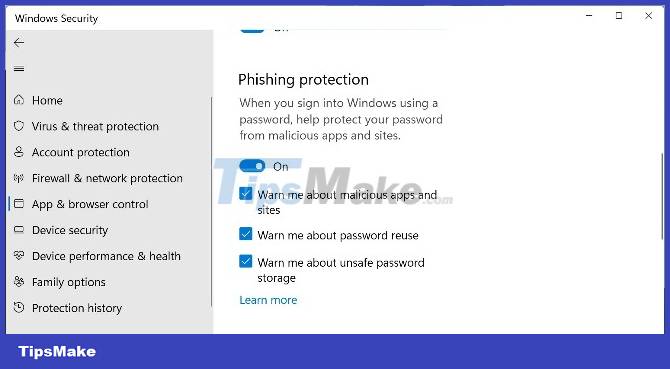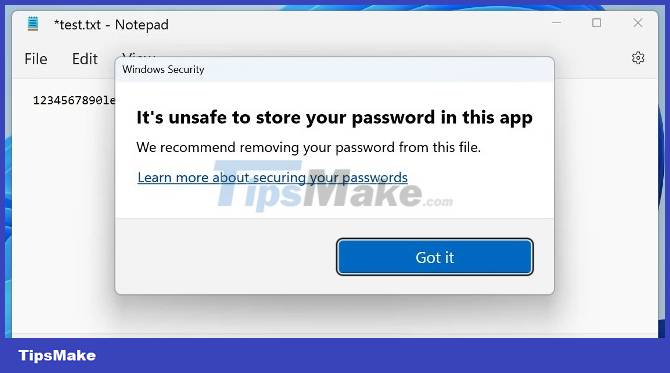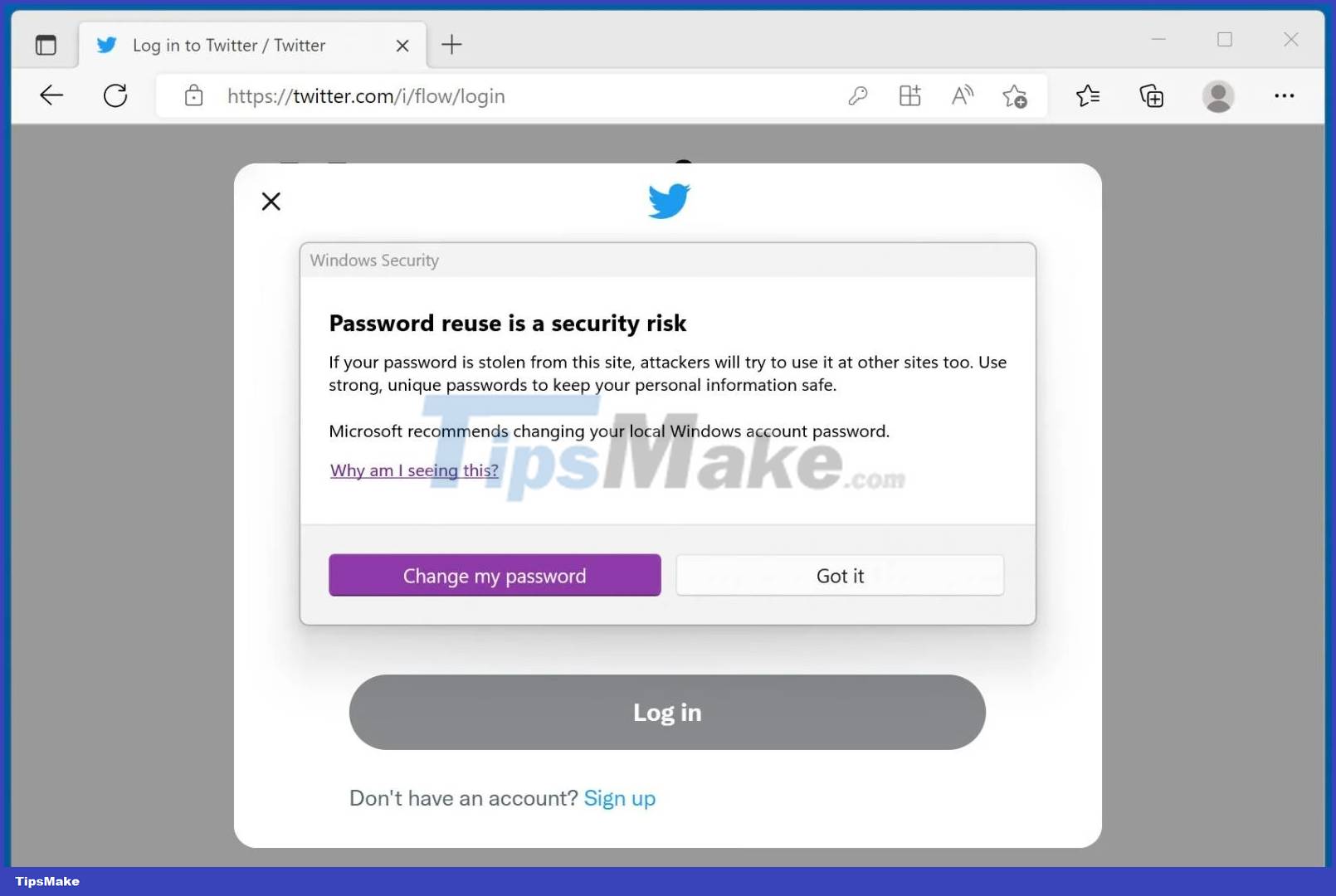How to turn on Enhanced Phishing Protection on Windows 11 to display warnings when entering passwords into Notepad and websites
Hackers often steal these passwords through phishing attacks or by users saving passwords in insecure applications, such as word processors, text editors, and spreadsheets. .
In some cases, just by entering the password into the fraudulent login form and not clicking submit, your password has been stolen by hackers.
To prevent this, Microsoft has introduced a new feature called Enhanced Phishing Protection on Windows 11 22H2 with the ability to warn users when they enter Windows passwords into unsafe applications or on websites.
"SmartScreen identifies and protects against password entering on phishing websites or apps connected to phishing websites, password reuse across any app or website, and passwords being imported into Notepad, Wordpad or Microsoft 365 apps ," explains Microsoft Security Product Manager Sinclaire Hamilton.
"IT admins can set up which situations require alerts to be sent to end users via CPS/MDM or Group Policy" .

At the moment, this new feature is currently only available on Windows 11 22H2 and it is not enabled by default. It also requires you to sign in to Windows with your Windows password instead of using Windows Hello.
Therefore, when you use a PIN to sign in to Windows, this feature will not work.
When enabled, Microsoft will detect when you enter your Windows password and then issue a warning prompting you to remove the password from an insecure file or, when entered on a website, to change your Windows password. .
How to turn on Enhanced Phishing Protection
Although Windows 11 22H2 has anti-phishing protection enabled by default, your password protection option is disabled.
To enable this option, you need to go to Start > Settings > Privacy & security > Windows Security > App & browser control > Reputation-based protection settings.
In the Phishing protection section, you will see two new options: "Warn me about password reuse" and "Warn me about unsafe password storage".
When enabled, the "Warn me about password reuse" option will display a warning when you enter your Windows password on a website whether it is a phishing website or a legitimate website.
Meanwhile, the "Warn me about unsafe password storage" option will display a warning when you enter passwords into applications like Notepad, Wordpad, and Microsoft Office then press Enter.

To protect your password, check both of these options to enable them. As you enable each option, Windows 11 displays a UAC prompt for you to confirm the settings.
In Bleeping Computer's test below, Windows 11 displays a warning when entering a password into Notepad and pressing Enter. Accompanying the warning is advice that users should remove the password from the file. Other applications that also display warnings include WordPad and Microsoft Word 2019.

However, it does not display a warning when entering passwords in Excel 2019, OneNote and Notepad 2. This needs to be reviewed and corrected because Excel is often used if it is necessary to create a list of passwords.
Another thing to note is that Windows 11 only displays warnings when using Google Chrome and Microsoft Edge. Similar test on Mozilla Firefox, the warning does not appear.

Overall, this is a great security feature for Windows users, and you should use it to protect yourself from phishing attacks and avoid saving your passwords in insecure applications.
However, there's still a lot of room for improvement, and Microsoft needs to expand this security feature to support more browsers and apps.
You should read it
- How to retrieve a Tik Tok password when it is lost
- Warning of duplicate values in Excel - Warning of data duplication
- How to set a password for a Windows 8 / 8.1 computer
- Instructions for changing Windows passwords without having to remember the old password
- How to remove PDF file password
- How to crack Windows 10 password, how to break password on Windows 10
- Check the security of the password
- Set BIOS and UEFI password to protect data on your Windows 10 computer safely
May be interested
- Why is Notepad still a great note taking application?
 we are in an age where there are countless hyperlinked note-taking apps, one that has always been there, simple yet really effective: windows notepad. here are the reasons why you should make a habit of using notepad to take notes.
we are in an age where there are countless hyperlinked note-taking apps, one that has always been there, simple yet really effective: windows notepad. here are the reasons why you should make a habit of using notepad to take notes. - Reset Notepad to the initial default setting state
 notepad is one of the most used applications on the windows operating system. during use, the notepad font is changed, corrupted, the notepad window size is changed, and some other errors. so to fix the error, you must reset notepad to the initial default setting.
notepad is one of the most used applications on the windows operating system. during use, the notepad font is changed, corrupted, the notepad window size is changed, and some other errors. so to fix the error, you must reset notepad to the initial default setting. - If you've overlooked Notepad before, it's time to reconsider!
 with the latest updates, microsoft has transformed one of these tools, notepad, into a pretty handy writing tool that you will now find hard to ignore.
with the latest updates, microsoft has transformed one of these tools, notepad, into a pretty handy writing tool that you will now find hard to ignore. - Differences between Notepad and WordPad in Windows
 if you have been properly trained in microsoft word, you have probably never 'touched' other editing programs on windows such as notepad and wordpad. both notepad and wordpad are developed by microsoft itself, and are integrated on windows versions, however notepad and wordpad only support and cannot be compared with word. to better understand the difference between notepad and worpad in windows, please refer to the article below.
if you have been properly trained in microsoft word, you have probably never 'touched' other editing programs on windows such as notepad and wordpad. both notepad and wordpad are developed by microsoft itself, and are integrated on windows versions, however notepad and wordpad only support and cannot be compared with word. to better understand the difference between notepad and worpad in windows, please refer to the article below. - How to quickly open the data file with the Notepad editor
 if you only handle common text content, without editing, the notepad software available on your computer will be the first choice. and we can re-open the file with a quicker notepad than the usual one.
if you only handle common text content, without editing, the notepad software available on your computer will be the first choice. and we can re-open the file with a quicker notepad than the usual one. - Notepad will be absent from the Store on Windows 10
 microsoft has just changed its mind, not moving notepad to the store in the upcoming 20h1 update.
microsoft has just changed its mind, not moving notepad to the store in the upcoming 20h1 update. - 7 ways to fix Notepad not opening error on Windows
 notepad is a simple text editor that comes pre-installed on your windows computer. you can use it to view, create and edit text files whenever needed. but what if windows can't open notepad and you can't use it?
notepad is a simple text editor that comes pre-installed on your windows computer. you can use it to view, create and edit text files whenever needed. but what if windows can't open notepad and you can't use it? - How to report phishing and malicious websites in Google Chrome
 now you can easily report phishing and malicious websites in chrome with the help of extensions. let's see how to do it.
now you can easily report phishing and malicious websites in chrome with the help of extensions. let's see how to do it. - 3 ways to display passwords *** on the browser is extremely simple
 usually the password you save on the browser is usually hidden under a *** or a dot so that strangers can't steal your password. however, suppose if you entered a wrong password, for example, and you want to display the password to see where the error is.
usually the password you save on the browser is usually hidden under a *** or a dot so that strangers can't steal your password. however, suppose if you entered a wrong password, for example, and you want to display the password to see where the error is. - How to Install Notepad++ on Linux
 notepad++ is a popular source code editor among windows users. it supports nearly 78 different programming language syntaxes and includes a lot of features to improve the editing experience.
notepad++ is a popular source code editor among windows users. it supports nearly 78 different programming language syntaxes and includes a lot of features to improve the editing experience.










 7 tips for better desktop tab management when working on Windows 11
7 tips for better desktop tab management when working on Windows 11 How to use the Calendar application on Windows 11
How to use the Calendar application on Windows 11 Windows 11 adds a new optical text recognition feature to the Snipping Tool
Windows 11 adds a new optical text recognition feature to the Snipping Tool How does Windows 11's new backup feature work?
How does Windows 11's new backup feature work? Windows 11 21H2 is about to die, Microsoft pushes to update version 23H2/22H2
Windows 11 21H2 is about to die, Microsoft pushes to update version 23H2/22H2 Error on Windows 11 makes File Explorer magically open files faster
Error on Windows 11 makes File Explorer magically open files faster